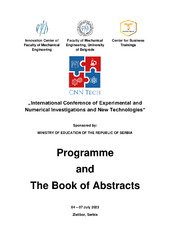Prikaz osnovnih podataka o dokumentu
Fractal analysis and microstructure development of BaTiO3 and PVDF based multifunctional materials
| dc.creator | Peleš Tadić, Adriana | |
| dc.creator | Vuković, George | |
| dc.creator | Kojović, Aleksandar | |
| dc.creator | Stojanović, Dušica | |
| dc.creator | Vlahović, Branislav | |
| dc.creator | Milosavljević, Nataša | |
| dc.creator | Obradović, Nina | |
| dc.creator | Pavlović, Vladimir B. | |
| dc.date.accessioned | 2023-10-03T13:35:48Z | |
| dc.date.available | 2023-10-03T13:35:48Z | |
| dc.date.issued | 2023 | |
| dc.identifier.isbn | 978-86-6060-155-3 | |
| dc.identifier.uri | https://dais.sanu.ac.rs/123456789/14969 | |
| dc.description.abstract | Barium titanate (BaTiO3) and polyvinylidene fluoride (PVDF) based multifunctional materials are attracting a great scientific interest due to their excellent piezoelectric, pyroelectric and ferroelectric properties. These materials undergo controlled transformations through physical interactions and respond to environmental stimuli, such as temperature, pressure, electric and magnetic fields. Their properties strongly depend on synthesis procedures and obtained microstructures. This include intergranular contact surfaces of BaTiO3 based materials, as well as, porous structure and cross-linking patterns of PVDF prepared by electrospinning. It has been found that these microstructures can have fractal structure and that the fractal analysis can be used as a powerful tool for describing structural and functional properties of these materials. Having this in mind, in this research we have used different fractal methods for the reconstructions of various BaTiO3 and PVDF microstructure morphologies. Fractal analysis has been performed by using scanning electron microscope micrographs and computational modeling tools. Fractal dimension of irregular morphologies which exhibit fractal regularity were determined by using box-counting method. This method enables the analysis of self-similar microstructure morphologies by quantifying the rate at which an object's geometrical details develop at increasingly fine scales. Theory of Iterated Function Systems and Voronoi tessellation, have been used for modeling BaTiO3 random microstructures and PVDF porous structures. A python algorithm was created to determine the distribution of pore areas in SEM micrographs. Algorithm’s distribution of calculated pore surface areas was compared with measured pore surface areas and fractal reconstructions of different morphologies and their connection with functional properties were analyzed. | sr |
| dc.language.iso | en | sr |
| dc.publisher | Belgrade : University of Belgrade - Faculty of Mechanical Engineering | sr |
| dc.relation | info:eu-repo/grantAgreement/MESTD/inst-2020/200175/RS// | sr |
| dc.relation | info:eu-repo/grantAgreement/MESTD/inst-2020/200135/RS// | sr |
| dc.relation | info:eu-repo/grantAgreement/MESTD/inst-2020/200116/RS// | sr |
| dc.relation | US National Science Foundation grant HRD-1345219 | sr |
| dc.relation | National Science Foundation grant DMR-1523617 | sr |
| dc.relation | US Department of Energy/National Nuclear Security Administration (Grant: NA0003979) | sr |
| dc.rights | openAccess | sr |
| dc.rights.uri | https://creativecommons.org/licenses/by/4.0/ | |
| dc.source | Programme and The Book of Abstracts / International Conference of Experimental and Numerical Investigations and New Technologies - CNN TECH 2023, 04 – 07 July 2023, Zlatibor, Serbia | sr |
| dc.subject | barium titanate | sr |
| dc.subject | BaTiO3 | sr |
| dc.subject | polyvinylidene fluoride | sr |
| dc.subject | PVDF | sr |
| dc.subject | electrospinning | sr |
| dc.subject | fractals | sr |
| dc.subject | Voronoi tessellation | sr |
| dc.title | Fractal analysis and microstructure development of BaTiO3 and PVDF based multifunctional materials | sr |
| dc.type | conferenceObject | sr |
| dc.rights.license | BY | sr |
| dc.citation.spage | 46 | |
| dc.type.version | publishedVersion | sr |
| dc.identifier.fulltext | http://dais.sanu.ac.rs/bitstream/id/60019/Peles-Tadic_CNN_book_of_abstracts.pdf | |
| dc.identifier.rcub | https://hdl.handle.net/21.15107/rcub_dais_14969 |

